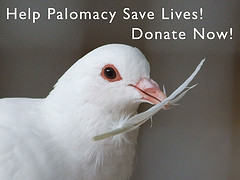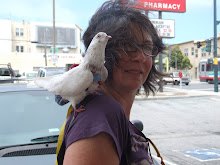Lab Pigeons Can Count

It was Thursday, January 27th and would have been my late mom's 82nd birthday. I had just spent a couple of hours at the Rotary Nature Center assessing and treating and stressing over 12 king pigeons that had been dumped like trash in an Oakland parking lot and was on my way to the vet with three of them when I checked email on my phone and found a message asking for help for 10 lab-test pigeons that were no longer needed. Really?!
These birds were lucky because they had an advocate. Lab Tech Jessica reached out to MickaCoo so that these laid-off birds would not be euthanized.



It took me a while to figure out how we were going to be able to absorb this many more pigeons on top of the dumped 12 and all the rest already in our foster care. Thanks to the help we received from Harvest Home Animal Sanctuary, we were able to help these birds too.
MickaCoo volunteer Cheryl Dickinson led this rescue. Here's her report and photos.
On February 12, I took the task of going to evaluate, treat and take pick up the pigeons. When I arrived the pigeons were in the science building in an interior room without windows. Each bird was kept in a small metal cage with a wire bottom and a wood perch to stand on. They were let out daily in a small aviary. Knowing the needs of pigeons, I knew there would be a huge improvement in their life upon being let into an aviary with plenty of air, sunshine and rain. It was hard to imagine what life they had in those enclosures for the past 3 years, without natural light, a mirror, greens or other pigeons to interact with on a regular basis. All the same, I was happy we were contacted and could be a resource to care for Dr. Cerutti's beloved pigeons.









If you or anyone you know are interested in adding some homers to an outdoor aviary life, these mellow and happy birds, all with the proven ability to count, are for you.
MickaCoo was contacted about ten tame lab homing pigeons needing homes. Dr. Cerutti was the professor who worked with the pigeons since May 2008 and had unexpectedly passed away in January. More times than not lab animals in this situation are euthanized so we were very glad to get the call. Jessica had lovingly helped care for them for the past year.




On February 12, I took the task of going to evaluate, treat and take pick up the pigeons. When I arrived the pigeons were in the science building in an interior room without windows. Each bird was kept in a small metal cage with a wire bottom and a wood perch to stand on. They were let out daily in a small aviary. Knowing the needs of pigeons, I knew there would be a huge improvement in their life upon being let into an aviary with plenty of air, sunshine and rain. It was hard to imagine what life they had in those enclosures for the past 3 years, without natural light, a mirror, greens or other pigeons to interact with on a regular basis. All the same, I was happy we were contacted and could be a resource to care for Dr. Cerutti's beloved pigeons.


The pigeons were used in a college psychology department lab "to understand the timing behavior of birds and fish working for delayed rewards." They used a clear box enclosure that had lights and feed stations to train the pigeons to respond to colors and count the flashes of light. It proved that pigeons could tell color and count. Although the pigeons were being cared for and loved, they were missing several enrichment's that could have made them a lot happier in their working life. We recommend larger enclosures, more interaction with each other, placement near a window and/or outdoor access, different size perches for foot health and a mirror which they like. I like to hope that the experience these 10 pigeons had can better the life of anyone reading this that knows of other lab pigeons.


After I had evaluated and treated all the pigeons they were boxed up and off I went to Berkeley to deliver the six feistiest of the ten to a wonderful foster aviary in Berkeley. It was a fabulous and over whelming feeling to release these six birds in the aviary and see how wonderful it was for them to be so free in the open air. They seemed to be happy within just seconds of the release and are doing really well.





I brought the other four quieter, special needs pigeons with me. Two of the four I had were labeled tame, but I found they really did want to be free in the aviary rather than handled. Binky is a super cute pigeon who has some disorder and falls sideways, like she once had PMV or has some sort of vertigo. Perry is very mellow also and neither really interact with other birds, they just sit. We first thought they should be fostered indoor, but after seeing them in the outdoor aviary, i know all these ten birds deserve an outdoor aviary life. After one week, the birds I have are all becoming more pigeon-like and enjoying themselves. Teller, who was thought to be male is actually female and is being courted by an unreleasable wing-injured feral called Spark. Doogie instantly embraced aviary life and is flirting with all the hens.




If you or anyone you know are interested in adding some homers to an outdoor aviary life, these mellow and happy birds, all with the proven ability to count, are for you.
Please consider providing a home to these or other homeless animals. Complete MickaCoo's new online application to start the adoption process.
Read I Was an Animal Experimenter by Paul Gazda
Read I Was an Animal Experimenter by Paul Gazda











1 Comments:
Elizabeth, the stories of rescue and salvation get more dramatic and awe-inspiring each time. Looking forward to the day when Hugh and I can own one of the aviaries on your go-to list. Beautiful, compassionate work, as always. My admiration always >>> Elizabeth!
Post a Comment
Subscribe to Post Comments [Atom]
<< Home